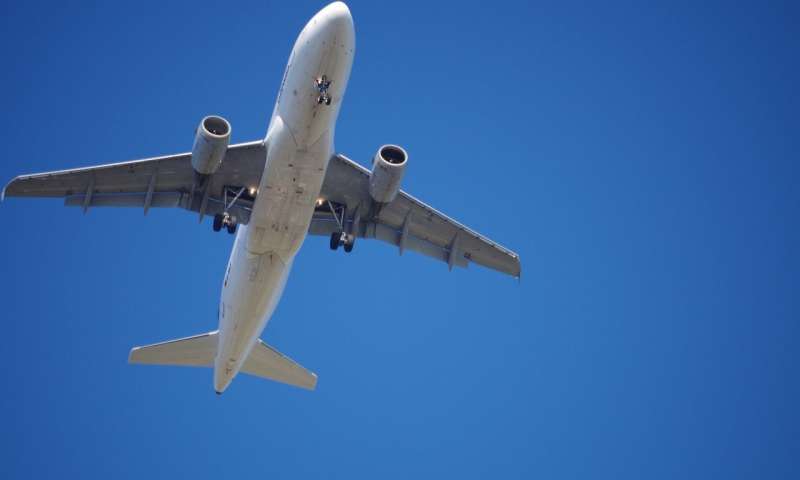
Prolonged exposure to loud noise is more than annoying—it is bad for human health. Beyond the obvious potential damage to hearing, chronic noise exposure has also been linked to adverse cardiovascular effects, such as increased risks of heart attacks and strokes.
Now, for the first time, researchers have provided a causal estimate linking high-level noise exposure to another key health challenge: low birth weight (< 2,500 grams or approximately 5.5 pounds).
Health economists from Lehigh University, Lafayette College and the University of Colorado, Denver were able to pinpoint a causal link by studying residential neighborhoods impacted by recent changes in airplane flight patterns going in and out of Newark Liberty International Airport, one of the largest airports in the United States.
Muzhe Yang, who holds the Francis J. Ingrassia 75 and Elizabeth McCaul Endowed Professorship in Lehigh’s Department of Economics, along with Laura Argys from University of Colorado, Denver and Susan Averett from Lafayette College, used unique birth records from 2004 to 2016 containing information on mothers’ home addresses and National Transportation Noise data providing measured noise levels at exact locations. Their analysis revealed an increase of 1.6 percentage points—or 22 percent—in the risk of having a low birth weight baby among mothers living close to the airport, in the direction of the runway, exposed to noise levels over the 55 dB threshold (the threshold used by the EPA and the WHO for the protection of public health), and during the period when the new flight pattern changes were more actively implemented at the airport.
Their paper describing these results, “Residential Noise Exposure and Health: Evidence from Aviation Noise and Birth Outcomes,” was published online Friday in the Journal of Environmental Economics and Management.
“Our findings have important policy implications regarding the trade-off between flight pattern optimization and human health,” says Yang. “This is especially important given the long-term negative impact of low birth weight on a range of later-life outcomes such as lifetime earnings, educational achievement and long-term health.”
Unintended Consequences
The changes in flight patterns around the Newark airport, as well as many airports in the United States, were triggered by a Federal Aviation Administration (FAA) air traffic control initiative called the Next Generation Air Transportation System, known as NextGen. Designed to reduce flight time and save fuel, one component of NextGen employs precision satellite monitoring instead of old-fashioned radar to guide airplanes. These satellite-designed optimum routes are made to be more direct. The use of satellite monitoring allows for more planes in the air, safely spaced and flying closer together, so more planes can use the same route.
Usage of these new routes by more and more aircraft and the adoption of a gradual descent approach—resulting in planes coming in to land at lower altitudes-have exposed residents living in areas under the satellite-designed routes to, as one resident impacted by changes in Arizona told CBS News, “a constant barrage of airplanes flying over their homes.”
NextGen provided the researchers with a rare circumstance to study the causal effect of noise pollution on birth weight, in which noise exposure is close to being randomly assigned because residents were caught off-guard. The implementation of NextGen by the FAA was exempted by the U.S. Congress from normal environmental impact reviews and public hearings. The randomness and the sharp change in noise exposure are important to ensure that the estimated effect of noise pollution on birth weight is not confounded by other factors that are related to both noise pollution and fetal health, such as air pollution. This study focuses on mothers living close to the airport, where air pollution is likely to be evenly distributed while sharp changes in noise pollution exist.
“The National Transportation Noise data provided a map that revealed sharp changes in noise exposure in areas near the airport,” says Yang. “We find that NextGen indeed created a narrow band around the runways, which is a noise pollution corridor. We argue that conditional on those who already live close to the airport, the redistribution of aviation noise, due to NextGen, occurred in a way that is outside of the residents’ control—since the NextGen’s implementation was exempted from public hearings.”
Furthermore, by focusing on those living close to the airport, the research team argues that “people probably do not have the knowledge about the exact landing and takeoff paths of aircraft, or they may think they will be exposed to similar levels aviation noise since landing and takeoff paths, prior to NextGen, were less concentrated.” Thus, there is a plausibly exogenous variation in noise exposure among those living near the airport—whether or not the mother lives inside the noise pollution corridor can be random. In their study they focus on mothers living within 5 miles of the airport.
Source: Read Full Article


